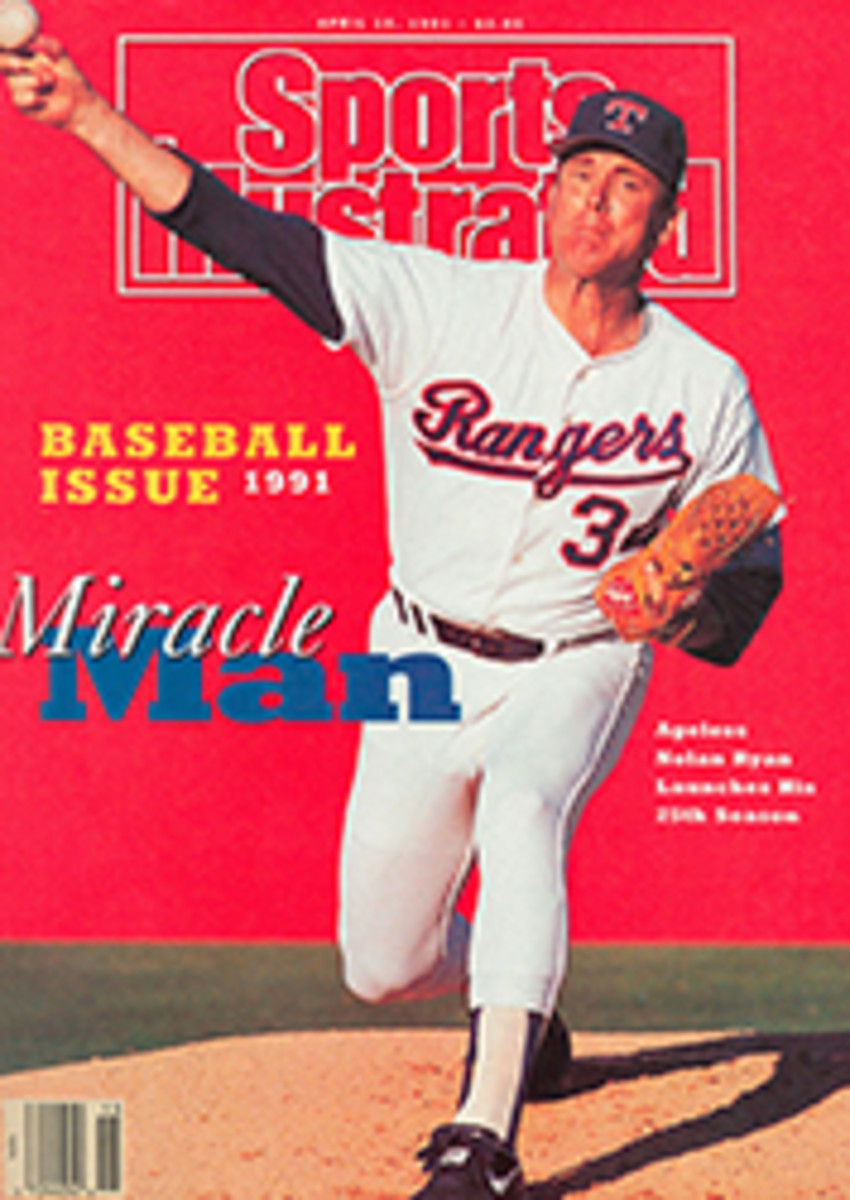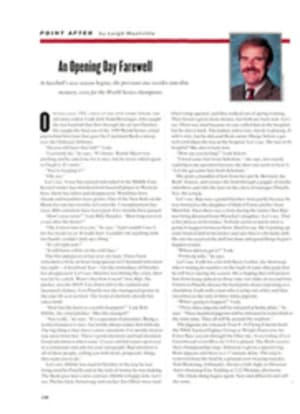
Cloudy Future for Antique Parks
Fenway Park and Tiger stadium were 79 years old on Opening Day. Wrigley Field, a comparative youngster, was 75. Wonderful chunks of baseball history have unfolded in these relics, and a visit to any of them can be as moving as a gospel service. But like a 40-year-old pitcher, the parks are showing their age, and they may not be able to hang on much longer.
It's not that they're falling apart structurally. The problem is economics and a sports world gone mad. The average major league salary has nearly doubled in the last four years, to almost $800,000, and $3 million-a-year players have become commonplace. Ball clubs that play in aged stadiums can't cover their spiraling costs as easily as teams that are housed in more modern facilities, and that has left such places as Fenway, Wrigley and Tiger Stadium with dubious futures. Says Michael Megna, a senior vice-president at American Appraisals Assoc, a Milwaukee firm that evaluates professional sports franchises: "If you look at it from a pure business sense, the old ballparks aren't economically viable anymore."
Why? The biggest reason is that they don't generate enough revenue. Consider luxury boxes. They're the first thing a team thinks of when it builds a stadium today, and rightly so, given the millions the boxes spin off. The SkyDome in Toronto, which opened in 1989, has 161 luxury boxes that rent for $90,000 to $200,000 a year on 10-year-minimum leases. These boxes alone bring in $35 million a year. But Tiger Stadium doesn't have any luxury boxes, and while the Cubs and Red Sox recently built suites (leased for $45,000-$65,000 and $50,000-$75,000 a year, respectively), they are far fewer in number and bring in substantially less money than the boxes in Toronto. "It's not always physically possible to add luxury boxes to the older stadiums," says Robert Baade, an economics professor at Lake Forest (Ill.) College. "And even when it is, the design of the park can really limit the size and number of boxes that can be built."
The newer stadiums also have plenty of other money-makers. Giant electronic scoreboards flash one advertisement after another during games, and every empty wall space is turned into a billboard. There are the so-called food courts, vast dining areas that cater to almost every gastronomical need and are designed to cut down on concession lines and increase sales volume. And don't forget the acres and acres of parking at the new parks, at about $5 a space. The older stadiums, which were built in the downtown areas of cities, simply don't have the room for parking lots. Says Baade: "The older parks are expanding in these areas as well, but they're limited by their design. No way they earn nearly as much as the more modern facilities."
Not surprisingly, maintenance is also a concern. "Tiger Stadium costs more than $1 million a year to keep up," says Bill Haase, senior vice-president in charge of planning and operations for the club. "We have problems with the electrical system, serious problems with the plumbing. Pieces of concrete are falling out of different places. How much bubble gum and glue do we use before everybody realizes that it's time we built something more efficient?"
But don't expect these senescent structures to be razed just yet. There are other forces, even stronger than bubble gum and glue, that are keeping them in business for the time being. One is sentiment. The old parks are sacred monuments, and tearing them down, even if it makes perfect business sense, would cause more trouble than Barry Bonds at an impromptu photo session. Look at what happened in Detroit in 1988, after the Tigers spoke of leveling their stadium and building better digs. More than 1,000 people circled the park one rainy April night and held hands in what was called a group hug. The Tiger Stadium Fan Club now boasts 12,000 members. Imagine the reaction if the Red Sox or Cubs talked about destroying their hallowed homes.
Another factor is the cost of building a new stadium. Prices start at about $150 million. Privately financed facilities, like Joe Robbie Stadium in Miami, are not always practical because they carry an onerous debt service, and taxpayers are increasingly reluctant to help pay for new facilities. (The San Francisco Giants, for instance, have been turned down three times by Bay Area voters on financing and building a new stadium to replace Candlestick Park.) So in most cases it has been cheaper to renovate than to build.
Finally, there's television money. Boston, Chicago and Detroit are among the nation's top eight TV markets, and their ball clubs enjoy some of the richest local media contracts in baseball. In Boston, for instance, the Red Sox bring in $10.8 million a year in TV rights fees; in Seattle, a much smaller market, the Mariners get only $1.5 million. Those extra millions enable teams to keep playing in their ancient stadiums, no matter how little revenue the parks produce.
So how much longer can the old parks survive?
Fenway Park: Structurally, it's in fine shape because of the regular maintenance it has received, and right now Fenway does well financially. But it's the smallest park in the majors, with room for only 34,142 people, and has half as many expensive box seats as, for example, Yankee Stadium has. The Red Sox have tried to solve the size problem by adding 41 private boxes in the mezzanine level and 610 premium-priced "club seats" on the roof, behind home plate, in what is called the 600 Club. Fenway has little room for more expansion, and even with all these additions, it won't be long before more revenue is needed to offset costs. "The Red Sox can't afford to stay in Fenway much longer," says Megna. "They'll be gone in 10 or 15 years."
Wrigley: The home of the Cubs has a bright future. It, too, is physically strong, and the Tribune Co., which owns the club and the park, has sunk $31 million into Wrigley in the past eight years (all the renovation will lower the yearly maintenance from close to $1 million to about half that amount). Lights went up, 66 luxury boxes were built, rest rooms and concession stands were expanded, clubhouses were renovated, and new seats were installed. Says Cub president Don Grenesko: "We've done all that we can do with Wrigley Field. If we did any more, then we might take away from the stadium's ambience."
Grenesko says the renovations will enable the Cubs to keep playing in Wrigley "indefinitely." And he scoffs at the notion that Wrigley might not be economically viable. "We'd be elsewhere if it wasn't," he says. Don't bet on it. With Comiskey Park gone and Soldier Field not far behind, the city wouldn't stand for the destruction of its last sports relic. Illinoisans are already paying for the construction of a new stadium for the White Sox, and they're in no rush to build another. Neither is the tightfisted Tribune Co., especially after all the money they've poured into Wrigley lately. The old place is safe for now. But Grenesko may have to alter the ambience of the friendly confines if players' salaries continue their dizzying upward spiral.
Tiger Stadium: The dugouts are cramped and leaky. The clubhouses are ridiculously small. The rest rooms get miserably overcrowded. The stadium has more low-cost bleacher seats than any other park in the majors—and no luxury suites. Clearly, something needs to be done with Tiger Stadium; the question is what. Tiger management wants to tear it down, and it is currently talking with private companies on formulating plans for a new stadium. "We've considered several options," says Haase, "and it all comes down to a new open-air, grass-field stadium. We'd like to be somewhere else by Opening Day 1995. That would be the best thing for all involved." Not as far as the Tiger Stadium Fan Club is concerned. "The stadium should be renovated, not destroyed," says John Davids, a Detroit-area architect who sits on the fan club's board of directors. "The team could add luxury suites, bring the entire stadium up to date, and even assign some space for future growth for far less than it would cost to construct a new home."
There's no telling how this will be resolved. However, Haase recently floated a proposal. "Tear down Tiger Stadium and put up a structure similar to the Navin Field of 1912 [the original structure that is now Tiger Stadium]," he says. "Let college and sandlot teams play in Tiger Stadium, and let the Tigers move to a new facility."
PHOTO
RICK STEWART/ALLSPORT USA
Boston added the posh 600 Club (left), but Fenway may be too small to survive financially.
PHOTO
DAMIAN STROHMEYER
[See caption above.]
PHOTO
JOHN IACONO
Toronto's SkyDome, with 161 luxury suites, is the model for stadium architecture.

